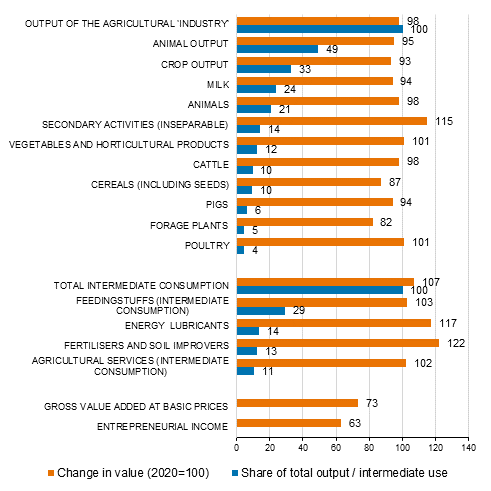Published: 9 December 2021
Entrepreneurial income from agriculture falling sharply in 2021
When output decreases and production costs increase, the share left for the entrepreneur decreases. This threat scenario seems to be realised for agriculture in 2021. The main reasons for the reduced output are the poor yield of cereals and the lower volume of milk production. As for production costs, higher prices of energy and fertilisers in particular increase production costs. According to the current forecast, entrepreneurial income from agriculture is expected to remain at only 63 per cent compared with last year's figure. The data derive from the Economic Accounts for Agriculture that are now published.
The share of agricultural product items in total output %, and the share of certain production inputs in intermediate consumption, % In addition, change in the current value of the above-mentioned items (2020=100) in 2021

The value of output and costs is usually calculated on the volume times price principle. In the national accounts, quantitative and qualitative changes are called volume changes. When comparing the development in the volume of individual agricultural products after 2020, the fall in the volume of cereal crops is as much as 24 per cent. However, the price of cereals rose slightly, so the current price value of cereal output only decreased by some 13 per cent. The volume of forage plant production also fell by around 17 per cent.
The combined volume of the entire crop production sector fell by around 10 per cent but because the price change was slightly positive, the value of output fell by only seven per cent. Data on horticulture for the current year are still fairly limited. The output volumes and prices are expected to remain close to the level of 2020.
The volumes of livestock production also went down in nearly all production lines. The weight of dairy production is high because it accounts for nearly one quarter of total agricultural output. The volume of milk production contracted by around 12 per cent, so it is strongly reflected in the development of the volume of the whole industry. The price of milk rose slightly, so the current price value of milk decreased only by around six per cent. Production volumes for poultry and pork have remained almost unchanged, while production volumes for beef have fallen by around three per cent.
A comprehensive picture of the changes in the volume of production inputs is not yet available. In turn, there are reliable data on price development. Prices of energy products have risen by nearly 20 per cent from last year. Together with the rise in the world market prices of fertiliser raw materials, this has led to an over 20 per cent increase in fertiliser prices. The poor fodder harvest together with the increase in other production costs has also put upward pressure on fodder prices.
Total output of agriculture at current prices is estimated to fall by good EUR 100 million from the previous year. In turn, the value of intermediate consumption is estimated to rise by over EUR 200 million. When intermediate consumption is subtracted from output, the result is gross value added. Gross value added at current prices is thus estimated to fall by over EUR 300 million from 2020. The change in the volume of gross value added at basic prices is estimated to decrease by about 18 per cent and when the price impact is also around 10 per cent negative, at current prices gross value added is estimated to fall by approximately 26 per cent.
Entrepreneurial income is calculated by subtracting consumption of fixed capital, wages and salaries paid, rents of land and interest paid from gross value added, and by adding subsidies on production to it. Entrepreneurial income thus appears to collapse from the previous year's EUR 950 million to around EUR 600 million.
The data for the Economic Accounts for Agriculture are produced at Statistics Finland as part of the production process of the national accounts. The compilation of the accounts is based on accounts harmonised and regulated by the EU. The accounts are compiled with uniform methods in all EU Member States. Data on all Member States can be found in Eurostat's database.
Source: Economic Accounts for Agriculture (EAA), Statistics Finland
Inquiries: Hannu Maliniemi 029 551 2796, maataloustilastot@stat.fi
Head of Department in charge: Katri Kaaja
Publication in pdf-format (225.2 kB)
- Tables
-
Tables in databases
Pick the data you need into tables, view the data as graphs, or download the data for your use.
Appendix tables
Updated 9.12.2021
Official Statistics of Finland (OSF):
Economic Accounts for Agriculture (EAA) [e-publication].
ISSN=2670-1006. 2021. Helsinki: Statistics Finland [referred: 17.7.2024].
Access method: http://www.stat.fi/til/eaa/2021/eaa_2021_2021-12-09_tie_001_en.html

